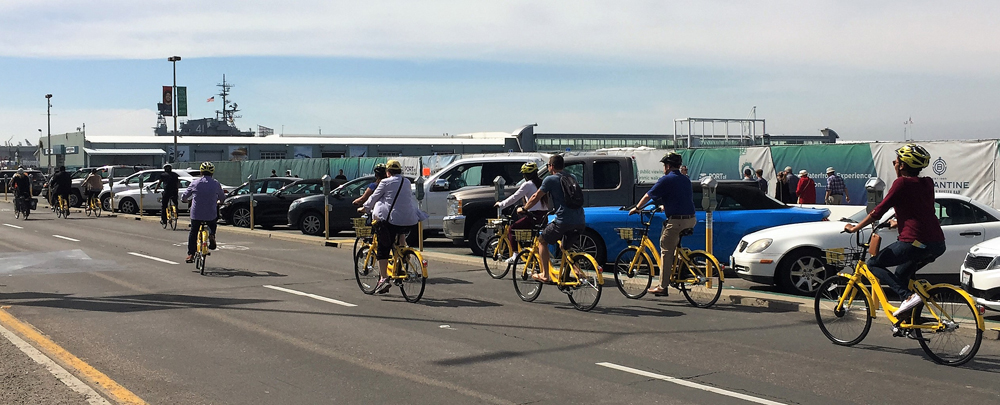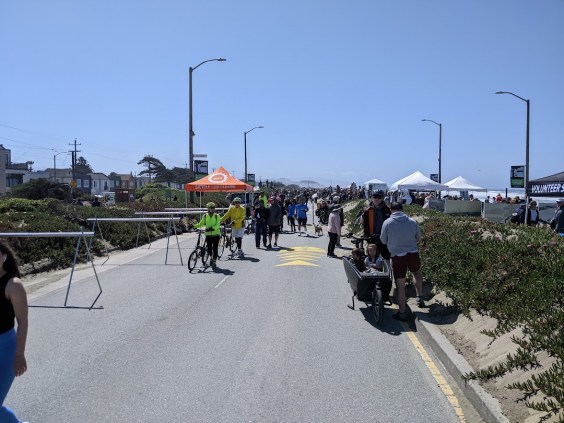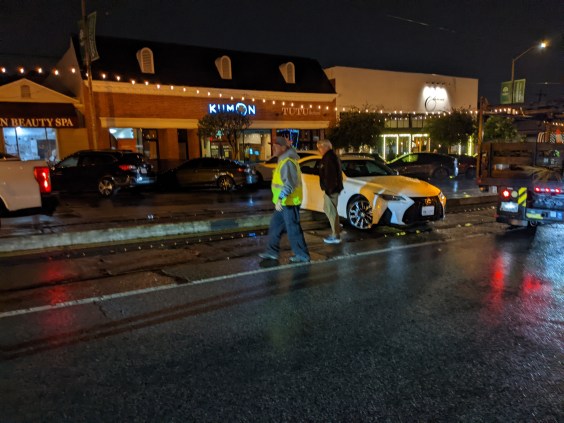Transportation is the largest contributor to climate emissions and pollution in California. Knowing this, state leaders have set goals to reduce those emissions in various ways, including increasing the number of "clean" vehicles in the mix. But the state Air Resources Board and others have made clear that the only sure way California will be able to reduce transportation emissions is by getting people to drive less.
However, "drive less" is not a politically popular idea, which has somewhat muted that message. While CARB's overall plan to reduce California emissions clearly says that we can't do it without reducing driving, but there is little consensus on how to do that. Caltrans, some eight years ago, set complementary goals to increase the use of transit, biking, and walking - but these seem to have been largely forgotten.
That is, in part, because California has failed to align its investments with these goals. Now a report from the Natural Resources Defense Council (NRDC) provides concrete data on just where California transportation investments are going - crucial information that advocates and the legislature have been pushing for.
How Much of its Money Does CA Invest in Fighting Climate Change
The NRDC analysis found that transportation agencies in California only allocate about eighteen percent of the available funding towards projects and programs that help curb reliance on private cars, including things like bike lanes, sidewalks, electric buses, mass transit, regional rail systems, and affordable housing. The state's largest source of funding by far is the State Highway Operations & Protection Program (SHOPP), which has a budget of over $16 billion for maintaining the state's roads and highways. "But only a little over $1 billion - or seven percent of SHOPP funding - has been successfully leveraged to implement projects that would substantially reduce VMT and deliver benefits to Californians walking, biking or taking public transit," writes Carter Rubin, Senior Transportation Lead with NRDC.
Much of the SHOPP funding goes towards rehabilitation and maintenance of existing roadways - at least, it is supposed to. But two programs funded by S.B. 1, which increased the state gas tax in 2017 - the Trade Corridor Enhancement Program (TCEP 2021) and the Solutions for Congested Corridors Program (SCCP 2020) - "allocated a majority of their funding to highway expansions that increase vehicle miles traveled (VMT)," according to the NRDC analysis.
The programs that invest in ways to reduce driving are numerous, but relatively small. They include the Active Transportation Program, the Affordable Housing and Sustainable Communities Program, and transit programs.
In all, California spends at least ten percent of its available funds on expanding roads and highways, increasing capacity for cars when we need to increase other kinds of capacity and decrease car use. It's a problem not just for climate pollution, but for air quality, urban sprawl, and traffic fatalities. "To zero out pollution from the transportation system," writes Rubin, "We need to stop expanding our roads and leverage maintenance investments to expand clean transportation options."
"This is an all-hands-on-deck effort that depends on fully aligning public spending with climate and clean air priorities," he adds.
He also gives leaders who haven't made this a priority an out: "Unfortunately, our elected and community leaders have lacked the information needed to understand if our transportation investments are enabling the polluting status quo or moving us down a better path," he writes.
But state leaders have been arguing exactly this - that the state needs to align its investments with climate change efforts and stop undermining its own goals - for the last several years. Multiple attempts have met with some limited success. These include the release of the Climate Action Plan for Transportation Investment, or CAPTI, which is more of a nudge in the right direction when what's needed is complete rethinking. Bills in the last few sessions and this one have tried to clear up the confusion - but there are still members of the legislature who pooh-pooh the research on induced demand and who insist that "Californians have to drive."
It doesn't have to be this way.
Following the Money
Ruben says the idea for the report began with the work advocates were doing on a regional Sustainable Communities Strategies. These are required as part of a region's Long Range Transportation Plans, and are supposed to push regions to look at the ways their transportation plans support climate-friendly development.
"All we would talk about was what was in the model," said Ruben, "but those models contain highway projects that were supposedly being offset by ambitious land use assumptions - lots of infill, for example - that weren't likely to happen."
So NRDC decided to look at it from a different angle, and follow the money. "What if we didn't assume a given -- that we're going to build all these counterproductive highway projects that won't help people get around without being stuck in traffic. Let's just look at what we're actually funding, not in a black box, but transparently. Let's see if our budgets are reflecting what we say is priority," he said.
And what they found is that the state budget does not yet reflect the state's commitments.
"This year's budget looks like we made some commitments to sustainable mobility," said Ruben, "but not enough. At the same time, it contains various existing and future commitments that are directly counterproductive to VMT reduction. The biggest amount is tied up in maintaining what is a massive maintenance liability. But we are also just adding to that liability by expanding highways, when we should be reducing that liability by taking cars and trucks off the road."
"The big thing that jumps out: billions of dollars going to highway widening that Caltrans hopes no one will notice."
And it's difficult for the public and state leaders to find information - this is one of the biggest issues highlighted by NRDC's report. "Say an assemblymember or a councilmember wanted to go to the state and ask: what projects are being funded in my district? First, who would they go to? There is no single source of truth for that information," said Ruben. "This is not conducive to having an informed public and elected leaders, and makes it impossible to follow the impact of these investments in their neighborhood."
Why Isn't California Doing This Analysis?
In the past, Caltrans has pointed out that their own system is so complex that even they can't answer the questions advocates have about where money is actually being invested and what impact those investments are having. Then there is the question of "the pipeline" of projects, which have been in the planning stages for years and waiting for funding. There doesn't seem to be a process for revisiting these projects, even though legislative leaders have been asking about it for several years.
"The hardest conversation seems to be acknowledging that there are projects on the books that were never really well-positioned to help meet the state values on equity and climate," said Ruben. "And some of them are especially unsupportable in light of what we now know about the climate. There is reluctance to revisit those, and naturally every project has champions."
"We should maintain those investments, but rescope the projects so they achieve the goals not by expanding highways and interchanges but by helping people move, and by cleaning up the freight sector."
Ruben also pointed out that there is plenty of evidence that building public transportation infrastructure can create as many or more jobs than highway infrastructure, which isn't always brought up when labor and industry objects that they need highways.
"I don't think there are unfortunate tradeoffs," he said. "For one thing, when you expand a highway, you spend millions on land acquisition. That doesn't create jobs. And the money could instead be spent on the infrastructure itself, like rail lines or bus rapid transit. These are ways also to help California meet its housing goals, especially because it is easier now to build housing in transit-rich areas. It's a win-win."
The NRDC report recommends several solutions to these issues. These will take political will and maybe re-education of some members of the legislature and of the public - who can start by reading the report.
The solutions include:
- Stop funding new highway capacity. Take a hard look at projects "in the pipeline" - that have been in the planning stages for years, and that may be getting funding now that under new infrastructure money is available - and make sure they align with state climate goals.
- Revise projects that have no impact on VMT to incorporate greater benefits to people walking, biking, and taking public transit. Caltrans could start with its recent Complete Streets policy, which should be implemented at scale on projects that Caltrans is involved in, as well as local and regional projects. Things like sidewalks, protected bike lane networks, and transit-only lanes should be incorporated into more projects.
- Build a better pipeline of VMT-reducing projects so that money can flow to shovel-ready and shovel-worthy projects.
- Create a more transparent process for tracking and reporting data on projects, so decision-makers and the public can better understand the overall impacts of our investment choices.
"With every year’s State budget and in every new program funding cycle, the State has an opportunity to more fully embrace a climate-friendly and equitable approach to funding transportation," writes Rubin. "That means investing in projects that connect communities rather than divide them, and provide clean and affordable options for all.






